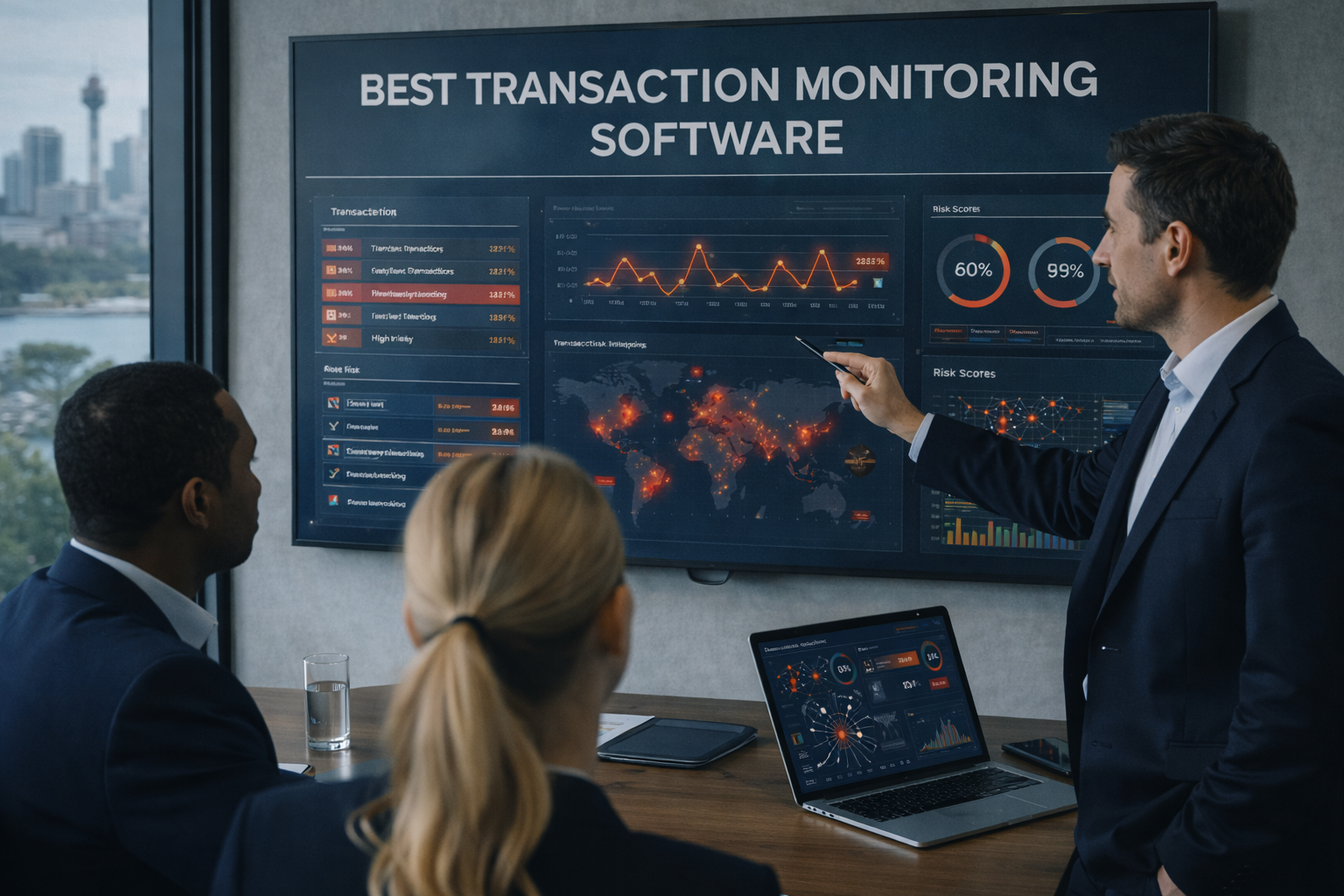Enhancing Security with Transaction Monitoring Software
.svg)
Today, banks and financial companies face many new challenges. They need to keep transactions safe and secure. As financial crimes like money laundering and fraud increase, having strong systems in place is more important than ever.
Transaction monitoring software emerges as a pivotal solution in this context, offering financial institutions a means to enhance their security measures. This article delves into the importance of transaction monitoring software and its role in bolstering security for financial institutions.
What Is Transaction Monitoring Software?
Transaction monitoring software serves as a critical system for financial institutions, enabling them to track and analyze financial transactions in real time. This technology is instrumental in detecting suspicious activities and ensuring compliance with Anti-Money Laundering (AML) regulations. By employing sophisticated algorithms and data analysis, transaction monitoring systems can identify anomalies and patterns that may signal fraudulent activities or money laundering attempts. Beyond mere observation, these systems provide actionable insights that allow financial institutions to take proactive measures against potential threats.
Furthermore, transaction monitoring software is not just a reactive tool; it is a proactive defense mechanism. By continuously scanning for irregularities, it empowers institutions to preemptively address issues before they escalate into significant problems. This capability not only enhances the security of financial operations but also instills confidence among stakeholders, ensuring that the institution remains a trusted entity in the eyes of regulators and customers alike.
{{cta-first}}
Why Is Transaction Monitoring Important?
Detecting Suspicious Activities
One of the primary functions of transaction monitoring software is to detect suspicious activities that could indicate fraudulent behavior. Utilizing advanced algorithms, the software identifies patterns that deviate from an individual's or entity's typical transaction behavior. For instance, if a customer suddenly initiates large, atypical transactions, the software flags this for further investigation. This early detection system is crucial for financial institutions to intercept potential fraudsters before they can execute significant damage or financial loss.
Moreover, by detecting these anomalies in real time, institutions can respond swiftly to mitigate risks. This not only prevents financial losses but also minimizes the potential reputational damage associated with financial crimes. The ability to act quickly and decisively is a key advantage of transaction monitoring software, allowing institutions to maintain operational integrity and customer trust.
Ensuring Compliance with AML Regulations
Compliance with AML regulations is a legal requirement for financial institutions, designed to thwart money laundering and related financial crimes. Transaction monitoring software plays a vital role in ensuring that institutions adhere to these stringent regulations. By continuously monitoring transactions, the software generates detailed reports that are indispensable for regulatory compliance and audits. These reports provide a transparent and comprehensive view of all monitored activities, which is essential for demonstrating compliance to regulatory bodies.
Additionally, staying compliant with AML regulations is not just about avoiding fines and penalties. It is about maintaining the institution's credibility and standing in the financial industry. Being compliant shows customers and partners that the institution follows ethical practices and works to prevent financial crimes. This helps improve its reputation and competitiveness.
Protecting the Institution's Reputation
The reputation of a financial institution is one of its most valuable assets, and it can be severely compromised by association with fraud or money laundering. Transaction monitoring software helps protect this reputation by reducing the risk of involvement in such activities. By effectively identifying and managing risks, institutions can avoid the negative publicity and loss of customer trust that often accompany financial scandals.
Furthermore, a strong reputation for security and compliance can differentiate an institution in a competitive market. Customers are increasingly aware of the risks associated with financial transactions and prefer to engage with institutions that prioritize security. By implementing robust transaction monitoring systems, financial institutions not only protect their reputation but also enhance customer loyalty and attract new clients who value security and integrity.
Key Features of AML Transaction Monitoring Systems
Real-Time Monitoring
Real-time monitoring is one of the most critical features of AML transaction monitoring systems. It allows financial institutions to detect and respond to suspicious activities as they occur, significantly minimizing potential damage. This feature ensures that no time is lost between the detection of an anomaly and the initiation of an appropriate response, thereby enhancing the security of financial operations.
In addition, real-time monitoring enables institutions to maintain continuous oversight of their transactions, providing a dynamic view of financial activities. This is crucial in a fast-paced financial environment where delays in response can lead to substantial losses or regulatory breaches. Real-time monitoring is thus an indispensable component of modern financial security strategies.
Automated Alerts
Transaction monitoring software is equipped with automated alert systems that notify relevant personnel when suspicious activities are detected. These alerts ensure that potential threats are promptly addressed, preventing them from going unnoticed. By directing alerts to the appropriate individuals or departments, institutions can ensure a swift and coordinated response to any identified threats.
Moreover, automated alerts reduce the reliance on manual oversight, which can be prone to human error. By automating the detection and notification processes, institutions can achieve higher accuracy and efficiency in managing potential risks. This automation not only streamlines operations but also enhances the overall security posture of the institution.
Comprehensive Reporting
Comprehensive reporting is a cornerstone feature of AML transaction monitoring systems. These reports provide detailed insights into all monitored transactions, highlighting any flagged activities that require further investigation. Such reports are invaluable for internal audits and regulatory compliance, offering a clear and concise overview of the institution's financial operations.
Furthermore, comprehensive reporting facilitates data-driven decision-making. By analyzing these reports, institutions can identify trends, assess risk levels, and refine their security strategies. This analytical capability enables institutions to stay ahead of potential threats and maintain a proactive stance in their security efforts.
Integration with Other Systems
Modern transaction monitoring software is designed to seamlessly integrate with other systems used by financial institutions, such as Customer Relationship Management (CRM) and Enterprise Resource Planning (ERP) systems. This integration facilitates seamless data transfer across various platforms, thereby improving the institution's operational efficiency and effectiveness.
Additionally, integration with other systems enables a holistic view of customer interactions and financial activities. This comprehensive perspective allows institutions to better understand their customers, improve service delivery, and tailor their security measures to address specific risks. By leveraging integrated systems, institutions can achieve greater operational synergy and security.
Benefits of Using AML Transaction Monitoring Software
Increased Efficiency
AML transaction monitoring software significantly increases the efficiency of financial institutions by automating the transaction monitoring process. This automation reduces the workload on personnel, freeing them to focus on critical tasks such as investigating flagged activities and enhancing customer service. As a result, institutions can optimize their resources and improve their overall operational efficiency.
Moreover, increased efficiency translates into cost savings. By streamlining processes and reducing the need for manual intervention, institutions can lower operational costs while maintaining high levels of security and compliance. This efficiency is a key advantage in a competitive financial landscape where cost management is crucial for success.
Reduced Risk of Financial Crimes
Transaction monitoring software plays a crucial role in reducing the risk of financial crimes by detecting suspicious activities in real time. This proactive approach helps prevent fraud and money laundering, thereby protecting both the institution and its customers. By minimizing the occurrence of financial crimes, institutions can maintain a secure environment for their operations.
Furthermore, reducing the risk of financial crimes enhances customer confidence. When customers are assured that their transactions are secure, they are more likely to continue their relationship with the institution. This trust is essential for building long-term customer loyalty and sustaining business growth.
Improved Compliance
AML transaction monitoring systems are designed to help financial institutions stay compliant with regulatory requirements. By ensuring that all transactions are monitored and reported in accordance with AML regulations, these systems reduce the risk of fines and other penalties associated with non-compliance. This compliance is crucial for maintaining the institution's legal standing and reputation.
Additionally, improved compliance fosters a culture of accountability within the institution. By consistently adhering to regulations, institutions demonstrate their commitment to ethical practices and responsible management. This commitment not only strengthens internal governance but also enhances the institution's credibility in the eyes of regulators and customers.
Enhanced Customer Trust
When customers know that their financial institution is taking comprehensive measures to protect their transactions, it significantly increases their trust in the institution. This trust can lead to increased customer loyalty and retention, as customers feel secure in their financial dealings. By prioritizing security, institutions can differentiate themselves in a crowded market and attract new customers who value safety and reliability.
Moreover, enhanced customer trust translates into a competitive advantage. In an era where consumers have numerous options, institutions that demonstrate a strong commitment to security and compliance are more likely to win customer loyalty. This loyalty is a key driver of sustainable growth and long-term success in the financial industry.
{{cta-ebook}}
Choosing the Right Transaction Monitoring Software
Scalability
When choosing transaction monitoring software, scalability is a critical factor to consider. As a financial institution grows, the software must be capable of handling an increasing volume of transactions without compromising performance. Scalable solutions ensure that institutions can continue to operate efficiently and securely as their business expands.
In addition, scalable software provides flexibility for future growth and adaptation. Financial institutions operate in a dynamic environment where business needs and regulatory requirements can change rapidly. By selecting scalable solutions, institutions can ensure that their transaction monitoring systems remain relevant and effective in the face of evolving challenges.
Customization
Every financial institution has unique needs and operational requirements. Therefore, it's essential to choose transaction monitoring software that can be customized to fit these specific needs. Customizable solutions offer maximum value by allowing institutions to tailor the software to their particular risk profiles and business objectives.
Moreover, customization enhances the software's effectiveness in addressing institution-specific risks. By aligning the software's features with the institution's unique requirements, institutions can achieve more precise monitoring and risk management. This tailored approach ensures that the software delivers optimal performance and security outcomes.
{{cta('c2265f53-7251-4b3c-91d7-20ef8707a8f3','justifycenter')}}
User-Friendly Interface
A user-friendly interface is crucial for the effective use of transaction monitoring software. Ensuring that the software is easy to navigate and that personnel can quickly learn how to use it enhances its overall utility. User-friendly systems facilitate seamless adoption and minimize training costs, allowing institutions to maximize the benefits of their investment.
Additionally, a user-friendly interface improves operational efficiency by reducing the time and effort required to manage the software. When personnel can easily access and interpret transaction data, they can make informed decisions more quickly and effectively. This ease of use is a key factor in achieving high levels of security and compliance.
Strong Customer Support
Robust customer support is essential when dealing with transaction monitoring software. Choosing a provider that offers strong customer support ensures that institutions have access to assistance whenever issues arise. This support is crucial for maintaining the software's functionality and reliability, especially in critical situations.
Furthermore, strong customer support enhances the institution's ability to leverage the software's full potential. By providing timely assistance and guidance, support teams help institutions optimize their use of the software and address any challenges that may arise. This partnership is vital for achieving long-term success and security in financial operations.
Transaction Monitoring Software from Tookitaki
Tookitaki's Transaction Monitoring Solution acts as a potent transaction monitoring software by leveraging advanced machine learning algorithms and a collective-intelligence approach to detect and prevent both fraud and money laundering activities in real-time. It integrates seamlessly with the Anti-Financial Crime (AFC) ecosystem, enabling financial institutions to benefit from comprehensive risk coverage and the most up-to-date defense mechanisms against emerging financial crimes. The solution's ability to dramatically reduce false positives enhances operational efficiency, ensuring that compliance teams focus on genuine alerts and suspicious activities effectively.
In today’s digital world, financial transactions are happening at an unprecedented rate, making it more important than ever to have robust security measures in place. Transaction monitoring software such as Tookitaki's, is a powerful tool that can help businesses detect and prevent money laundering and fraudulent activities, comply with regulations, and improve the customer experience.
Reach out to our experts to explore how Tookitaki's transaction monitoring solution can transform your transaction monitoring processes and strengthen your defenses against financial crimes.
Experience the most intelligent AML and fraud prevention platform
Experience the most intelligent AML and fraud prevention platform
Experience the most intelligent AML and fraud prevention platform
Top AML Scenarios in ASEAN

The Role of AML Software in Compliance

The Role of AML Software in Compliance










